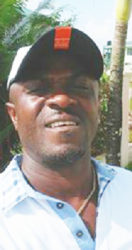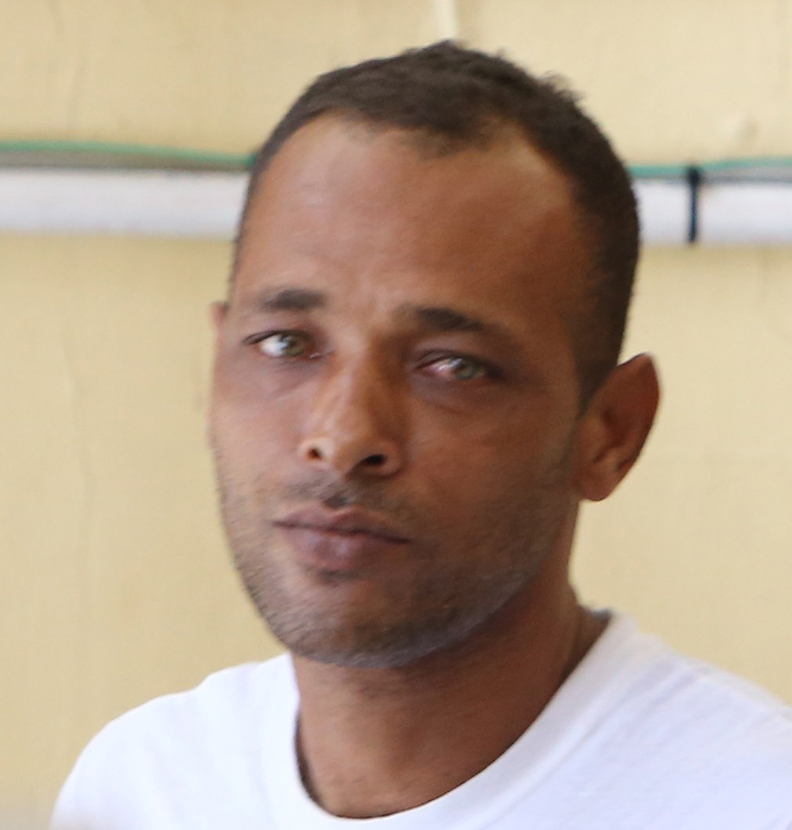Regan Rodrigues called ‘Grey Boy,’ was yesterday afternoon freed of the 2015 murder of political activist Courtney Crum-Ewing, after trial Judge Sandil Kissoon upheld a no-case submission made by defence attorney Adrian Thompson.
Finding that there was no case for the accused to answer, the judge directed the jury to return a formal verdict of not guilty, thereby discharging a visibly relieved Rodrigues who was moved to tears.
It had been the prosecution’s case that Rodrigues gunned down Crum-Ewing on the night of March 10th, 2015 at Third Avenue, Diamond Housing Scheme, East Bank Demerara.

Investigators who testified at the trial, had said that the now former-accused had claimed ownership of the gun, which ballistic testing proved was the very firearm used to kill Crum-Ewing.
Rodrigues, however, had denied ever making any such statement to police.
It was upon the ballistic evidence that the prosecution’s case rested solely.
At the conclusion of a preliminary inquiry (PI) on June 5th, 2017, Magistrate Judy Latchman had also found that a prima facie case had not been established and discharged Rodrigues, ruling that there was no case against him.
Two days later, however, Director of Public Prosecutions (DPP) Shalimar Ali-Hack issued a directive to the magistrate to take steps to commit Rodrigues to stand trial in the High Court for the capital offence.
However, Magistrate Latchman maintained that she would be unable to comply with the DPP’s directive, as she had found no evidence presented by the prosecution that it was Rodrigues who killed Crum-Ewing.
After the magistrate made it clear that she was not going to comply with the directive, the DPP commenced proceedings in the High Court, seeking among other things, that she show why her decision to discharge the accused, should not be declared ultra vires, null and void.
Noting her dissatisfaction with a subsequent ruling by Justice Brassington Reynolds, compelling her to act in accordance with the DPP’s ruling, Magistrate Latchman filed an appeal, contending, among other things, that the judge’s decision could not be supported, having regard to the evidence and the law.
That matter is still pending before the appellate court.
Having been previously found not guilty by a magistrate of being in possession of the gun at the centre of the case, Justice Kissoon yesterday noted in his ruling that the prosecution had failed to establish its case against Rodrigues.
Tenuous
“Defective” and “tenuous” were the words used by Justice Kissoon to describe the state’s case against the accused.
On January 11th, 2016 Magistrate Fabayo Azore found Rodrigues not guilty of the gun and ammunition possession charge which was the purported link between him and Crum-Ewing’s murder. Magistrate Azore had said that the prosecution failed to prove that Rodrigues had knowledge and possession of the articles.
Delivering his ruling on the no-case submission, Justice Kissoon yesterday referenced case law authorities by which he said he was guided on the issue, and noted therefrom that having been acquitted of being in possession of the gun which police said was used to kill Crum-Ewing, the capital charge against Rodrigues could proceed no further.
Justice Kissoon pointed out that that gun rested at the centre of the prosecution’s case, and with a not guilty finding that the accused was even in possession of it, it would be an injustice to send the case to the jury.
The judge explained that the acquittal by Magistrate Azore of the unlicensed firearm and possession charge was a finding of fact and law and had been settled by a court of competent jurisdiction, and that issue could therefore not be revisited by the jury.
To so do would be unjust, the judge noted, while adding that the law itself does not so permit.
Justice Kissoon said that with the magistrate having so found; for him to have sent the case to the jury would in essence be inviting the panel to speculate—which the law specifically shuns and with which even the best directions to the jury would be incapable of remedying.
The judge interjected at this point that the burden-of-proof standard which the prosecution had to meet was a finding of guilt “beyond reasonable doubt,” and not merely that the accused might possibly be guilty.
The judge went on to note that the jury could not in essence overrule the magistrate’s finding as; not only is that not justice, but that the law does not so allow. He said that in accordance with the principles of estoppel and res judicata, the matter decided upon by the magistrate regarding the unlicensed gun and ammunition charges could not be revisited by a jury.
The judge emphasized that having regard to the magistrate’s finding, it would have resulted in an inconsistent verdict, were the jury to convict based on the state’s case that Rodrigues was in possession of and had shot Crum-Ewing with the gun in question.
He said that the prosecution needed to establish at a prima face level, that the accused was first, in possession of that gun; which he made clear they failed to do.
Equation
When this is eliminated from the equation, Justice Kissoon said that there remains no evidence by the state against the accused. Against this background, the judge said that he could not call on Rodrigues to mount a defence as he had no case to answer.
The prosecution’s case he said, was therefore “defective” and “tenuous.” The judge then went further to point out that even in examining the alleged oral statements the police said Rodrigues gave, they all attributed to him saying that he “did not” kill Crum-Ewing.
In the circumstances, the judge upheld Thompson’s submissions and directed the jury formally to return a verdict of not guilty in favour of Rodrigues who appeared visibly relieved and was moved to tears after being informed that he was free to go.
In her opening address to the jury on Monday, Prosecutor Tyra Bakker had said that the state would prove beyond a reasonable doubt, that it was Rodrigues who had inflicted the fatal injuries on Crum-Ewing.
Several police witnesses had testified that it was the same gun used to kill Crum-Ewing that had been found in Rodrigues’ Riverview, Ruimveldt residence.
According to the police officers, the accused had admitted ownership of the .32 Taurus pistol which he said he had for some years prior, as a means of protection for his family.
The jury heard from police witnesses that Rodrigues had told them of having bought the gun, which had previously been used to kill someone else.
Thompson, however, challenged the testimonies of the several police officers whom he contended fabricated their stories against his client.
Thompson had said that his client at no time ever made the statements attributed to him by investigators, nor was any search ever conducted at his home or in his presence.
Superintendent of Police Mitchell Caesar had said the accused related that he had had the gun for some years prior which he had bought from a man whom he identified as “Patrick Smith” called “Pragso.”
According to Caesar, the accused then went on to relate that Smith had gotten the gun from his cousin who is incarcerated for the murder of the Rubis Gas Station Accountant at Meadowbrook.
Before the close of the prosecution’s case yesterday, retired Inspector of Police and ballistic expert, Eon Jackson testified that the bullets submitted to him for analysis which investigators had said were retrieved from Crum-Ewing’s body, as well as a number of spent shells and other live rounds belonged to the same gun with which the activist was shot dead.
He told the court that after conducting a microscopic examination, he found that all five fired casings had the same firing pin and striation marks in identical sequence which are unique to each firearm.
He said that like fingerprints, no two firearms would produce the same striation marking sequence, and it was because of this that he was able to conclude that it was the same gun—a .32 Taurus semiautomatic millennium pistol that had been used to kill Crum-Ewing.
Also testifying yesterday was Patholo-gist Dr. Nehaul Singh, who gave the cause of death as haemorrhage and shock due to multiple gunshot injuries. He said that Crum-Ewing was shot five times—at least one at close range to his neck.
The defence’s argument before Magistrate Azore had been that Rodrigues was not there when the gun was found and that in the case that the articles were discovered at the residence, an issue of multiple occupancy arises.
Magistrate Azore had explained that it was up to the prosecution to prove that Rodrigues knew the gun and ammunition existed and had possession and control of the articles.
She had stated that in regards to multiple occupancy, this fact was corroborated by witness testimonies from Rodrigues’ girlfriend as well as a police rank, who testified that he’d had cause to visit the residence on several occasions and knew of others living there at the time.
The magistrate had then gone on to state that the prosecution had not satisfied the court that the defendant had knowledge of the firearm, nor had they led evidence to suggest that he was the owner of the home. Furthermore, the items had not been discovered in Rodrigues’ bedroom or in a public place in the house, but had been concealed, which was enough to create reasonable doubt that the defendant knew of the articles’ existence.
Given these reasons, Rodrigues was found not guilty of the charge.
Crum-Ewing was killed on the evening of March 10, 2015 at Diamond, East Bank Demerara as he was urging residents to vote at the May, 2015 elections. He was shot five times, including three times to the head.





